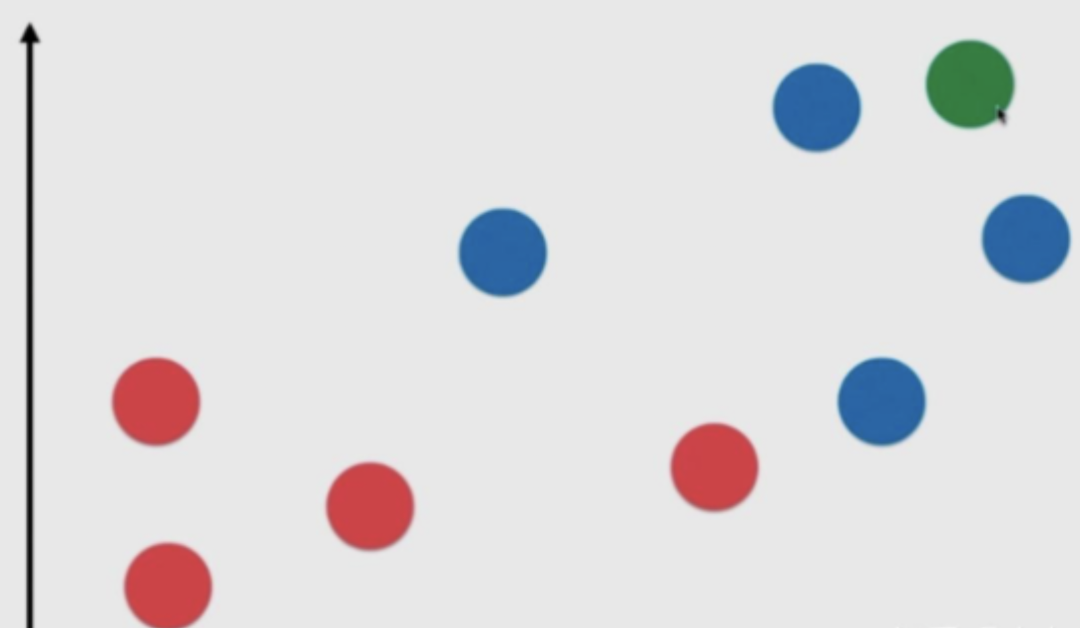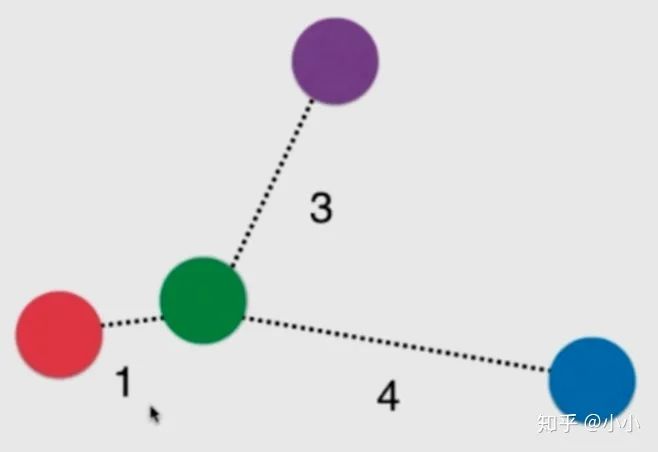來源:古月居
前言
KNN(k-Nearest Neighbors)思想簡單,應(yīng)用的數(shù)學(xué)知識幾乎為0,所以作為機(jī)器學(xué)習(xí)的入門非常實(shí)用、可以解釋機(jī)器學(xué)習(xí)算法使用過程中的很多細(xì)節(jié)問題。能夠更加完整地刻畫機(jī)器學(xué)習(xí)應(yīng)用的流程。
首先大致介紹一下KNN的思想,假設(shè)我們現(xiàn)在有兩類數(shù)據(jù)集,一類是紅色的點(diǎn)表示,另一類用藍(lán)色的點(diǎn)表示,這兩類點(diǎn)就作為我們的訓(xùn)練數(shù)據(jù)集,當(dāng)有一個新的數(shù)據(jù)綠色的點(diǎn),那么我們該怎么給這個綠色的點(diǎn)進(jìn)行分類呢?
一般情況下,我們需要先指定一個k,當(dāng)一個新的數(shù)據(jù)集來臨時,我們首先計(jì)算這個新的數(shù)據(jù)跟訓(xùn)練集中的每一個數(shù)據(jù)的距離,一般使用歐氏距離。
然后從中選出距離最近的k個點(diǎn),這個k一般選取為奇數(shù),方便后面投票決策。在k個點(diǎn)中根據(jù)最多的確定新的數(shù)據(jù)屬于哪一類。

KNN基礎(chǔ)
1.先創(chuàng)建好數(shù)據(jù)集x_train, y_train,和一個新的數(shù)據(jù)x_new, 并使用matplot將其可視化出來。
import numpy as np
import matplotlib.pyplot as plt
raw_data_x = [[3.3935, 2.3313],
[3.1101, 1.7815],
[1.3438, 3.3684],
[3.5823, 4.6792],
[2.2804, 2.8670],
[7.4234, 4.6965],
[5.7451, 3.5340],
[9.1722, 2.5111],
[7.7928, 3.4241],
[7.9398, 0.7916]]
raw_data_y = [0, 0, 0, 0, 0, 1, 1, 1, 1, 1]
x_train = np.array(raw_data_x)
y_train = np.array(raw_data_y)
x_new = np.array([8.0936, 3.3657])
plt.scatter(x_train[y_train==0,0], x_train[y_train==0,1], color='g')
plt.scatter(x_train[y_train==1,0], x_train[y_train==1,1], color='r')
plt.scatter(x_new[0], x_new[1], color='b')
plt.show()
1.knn過程
2.計(jì)算距離
from math import sqrt distance = [] for x in x_train: d = sqrt(np.sum((x_new - x) ** 2)) distance.append(d) # 其實(shí)上面這些代碼用一行就可以搞定 # distances = [sqrt(np.sum((x_new - x) ** 2)) for x in x_train]
輸出結(jié)果:
[10.888422144185997, 11.825242797930196, 15.18734646375067, 11.660703691887552, 12.89974598548359, 12.707715895864213, 9.398411207752083, 15.62480440229573, 12.345673749536719, 14.394770082568183]
將距離進(jìn)行排序,返回的是排序之后的索引位置
nearsest = np.argsort(distances)
輸出結(jié)果:array([6, 0, 3, 1, 8, 5, 4, 9, 2, 7], dtype=int64)
取k個點(diǎn),假設(shè)k=5
k = 5 topk_y = [y_train[i] for i in nearest[:k]] topk_y
輸出結(jié)果:[1, 0, 0, 0, 1]
根據(jù)輸出結(jié)果我們可以發(fā)現(xiàn),新來的數(shù)據(jù)距離最近的5個點(diǎn),有三個點(diǎn)屬于第一類,有兩個點(diǎn)屬于第二類,根據(jù)少數(shù)服從多數(shù)原則,新來的數(shù)據(jù)就屬于第一類!
投票
from collections import Counter Counter(topk_y)
輸出結(jié)果:Counter({1: 2, 0: 3})
votes = Counter(topk_y) votes.most_common(1) y_new = votes.most_common(1)[0][0]
輸出結(jié)果:0
這樣,我們就完成了一個基本的knn!
自己寫一個knn函數(shù)
knn是一個不需要訓(xùn)練過程的機(jī)器學(xué)習(xí)算法。其數(shù)據(jù)集可以近似看成一個模型。
import numpy as np from math import sqrt from collections import Counter def kNN_classifier(k, x_train, y_train, x_new): assert 1 <= k <= x_train.shape[0], "k must be valid" ? ?assert x_train.shape[0] == y_train.shape[0], "the size of x_train must be equal to the size of y_train" ? ?assert x_train.shape[1] == x_new.shape[0], "the feature number of x_new must be equal to x_train" ? ?distances = [sqrt(np.sum((x_new - x) ** 2)) for x in x_train] ? ?nearest = np.argsort(distances) ? ?topk_y = [y_train[i] for i in nearest[:k]] ? ?votes = Counter(topk_y) ? ?return votes.most_common(1)[0][0]
測試一下:
raw_data_x = [[3.3935, 2.3313],
[3.1101, 1.7815],
[1.3438, 3.3684],
[3.5823, 4.6792],
[2.2804, 2.8670],
[7.4234, 4.6965],
[5.7451, 3.5340],
[9.1722, 2.5111],
[7.7928, 3.4241],
[7.9398, 0.7916]]
raw_data_y = [0, 0, 0, 0, 0, 1, 1, 1, 1, 1]
x_train = np.array(raw_data_x)
y_train = np.array(raw_data_y)
x_new = np.array([8.0936, 3.3657])
y_new = kNN_classifier(5, x_train, y_train, x_new)
print(y_new)
使用sklearn中的KNN
from sklearn.neighbors import KNeighborsClassifier
import numpy as np
raw_data_x = [[3.3935, 2.3313],
[3.1101, 1.7815],
[1.3438, 3.3684],
[3.5823, 4.6792],
[2.2804, 2.8670],
[7.4234, 4.6965],
[5.7451, 3.5340],
[9.1722, 2.5111],
[7.7928, 3.4241],
[7.9398, 0.7916]]
raw_data_y = [0, 0, 0, 0, 0, 1, 1, 1, 1, 1]
x_train = np.array(raw_data_x)
y_train = np.array(raw_data_y)
x_new = np.array([8.0936, 3.3657])
knn_classifier = KNeighborsClassifier(n_neighbors=5)
knn_classifier.fit(x_train, y_train)
y_new = knn_classifier.predict(x_new.reshape(1, -1))
print(y_new[0])
自己寫一個面向?qū)ο蟮腒NN
import numpy as np
from math import sqrt
from collections import Counter
class KNNClassifier():
def __init__(self, k):
assert 1 <= k, "k must be valid"
? ? ? ?self.k = k
? ? ? ?self._x_train = None
? ? ? ?self._y_train = None
? ?def fit(self, x_train, y_train):
? ? ? ?assert x_train.shape[0] == y_train.shape[0],
? ? ? ?"the size of x_train must be equal to the size of y_train"
? ? ? ?assert self.k <= x_train.shape[0],
? ? ? ? "the size of x_train must be at least k"
? ? ? ?self._x_train = x_train
? ? ? ?self._y_train = y_train
? ? ? ?return self
? ?def predict(self, x_new):
? ? ? ?x_new = x_new.reshape(1, -1)
? ? ? ?assert self._x_train is not None and self._y_train is not None,
? ? ? ?"must fit before predict"
? ? ? ?assert x_new.shape[1] == self._x_train.shape[1],
? ? ? ?"the feature number of x must be equal to x_train"
? ? ? ?y_new = [self._predict(x) for x in x_new]
? ? ? ?return np.array(y_new)
? ?def _predict(self, x):
? ? ? ?assert x.shape[0] == self._x_train.shape[1],
? ? ? ?"the feature number of x must be equal to x_train"
? ? ? ?distances = [sqrt(np.sum((x_train - x) ** 2)) for x_train in self._x_train]
? ? ? ?nearest = np.argsort(distances)
? ? ? ?topk_y = [self._y_train[i] for i in nearest[:self.k]]
? ? ? ?votes = Counter(topk_y)
? ? ? ?return votes.most_common(1)[0][0]
? ?def __repr__(self):
? ? ? ?return "KNN(k=%d)" % self.k
測試一下:
raw_data_x = [[3.3935, 2.3313],
[3.1101, 1.7815],
[1.3438, 3.3684],
[3.5823, 4.6792],
[2.2804, 2.8670],
[7.4234, 4.6965],
[5.7451, 3.5340],
[9.1722, 2.5111],
[7.7928, 3.4241],
[7.9398, 0.7916]]
raw_data_y = [0, 0, 0, 0, 0, 1, 1, 1, 1, 1]
x_train = np.array(raw_data_x)
y_train = np.array(raw_data_y)
x_new = np.array([8.0936, 3.3657])
knn_clf = KNNClassifier(6)
knn_clf.fit(x_train, y_train)
y_new = knn_clf.predict(x_new)
print(y_new[0])
分割數(shù)據(jù)集
import numpy as np from sklearn import datasets def train_test_split(x, y, test_ratio=0.2, seed=None): assert x.shape[0] == y.shape[0], "the size of x must be equal to the size of y" assert 0.0 <= test_ratio <= 1.0, "test_ratio must be valid" ? ?if seed: ? ? ? ?np.random.seed(seed) ? ?shuffle_idx = np.random.permutation(len(x)) ? ?test_size = int(len(x) * test_ratio) ? ?test_idx = shuffle_idx[:test_size] ? ?train_idx = shuffle_idx[test_size:] ? ?x_train = x[train_idx] ? ?y_train = y[train_idx] ? ?x_test = x[test_idx] ? ?y_test = y[test_idx] ? ?return x_train, y_train, x_test, y_test
sklearn中鳶尾花數(shù)據(jù)測試KNN
import numpy as np from sklearn import datasets from knn_clf import KNNClassifier iris = datasets.load_iris() x = iris.data y = iris.target x_train, y_train, x_test, y_test = train_test_split(x, y) my_knn_clf = KNNClassifier(k=3) my_knn_clf.fit(x_train, y_train) y_predict = my_knn_clf.predict(x_test) print(sum(y_predict == y_test)) print(sum(y_predict == y_test) / len(y_test)) # 也可以使用sklearn中自帶的數(shù)據(jù)集拆分方法 from sklearn.model_selection import train_test_split import numpy as np from sklearn import datasets from knn_clf import KNNClassifier iris = datasets.load_iris() x = iris.data y = iris.target x_train, y_train, x_test, y_test = train_test_split(x, y, test_size=0.2, random_state=666) my_knn_clf = KNNClassifier(k=3) my_knn_clf.fit(x_train, y_train) y_predict = my_knn_clf.predict(x_test) print(sum(y_predict == y_test)) print(sum(y_predict == y_test) / len(y_test))
sklearn中手寫數(shù)字?jǐn)?shù)據(jù)集測試KNN
首先,先來了解一下手寫數(shù)字?jǐn)?shù)據(jù)集。
import numpy as np import matplotlib.pyplot as plt from sklearn import datasets digits = datasets.load_digits() digits.keys() print(digits.DESCR) y.shape digits.target_names y[:100] x[:10] some_digit = x[666] y[666] some_digit_image = some_digit.reshape(8, 8) plt.imshow(some_digit_image, cmap=plt.cm.binary) plt.show()
接下來,就開始動手試試。
from sklearn import datasets from shuffle_dataset import train_test_split from knn_clf import KNNClassifier digits = datasets.load_digits() x = digits.data y = digits.target x_train, y_train, x_test, y_test = train_test_split(x, y, test_ratio=0.2) my_knn_clf = KNNClassifier(k=3) my_knn_clf.fit(x_train, y_train) y_predict = my_knn_clf.predict(x_test) print(sum(y_predict == y_test) / len(y_test))
把求acc封裝成一個函數(shù),方便調(diào)用。
def accuracy_score(y_true, y_predict): assert y_true.shape[0] == y_predict.shape[0], "the size of y_true must be equal to the size of y_predict" return sum(y_true == y_predict) / len(y_true)
接下來把它封裝到KNNClassifier的類中。
import numpy as np
from math import sqrt
from collections import Counter
from metrics import accuracy_score
class KNNClassifier():
def __init__(self, k):
assert 1 <= k, "k must be valid"
? ? ? ?self.k = k
? ? ? ?self._x_train = None
? ? ? ?self._y_train = None
? ?def fit(self, x_train, y_train):
? ? ? ?assert x_train.shape[0] == y_train.shape[0],
? ? ? ?"the size of x_train must be equal to the size of y_train"
? ? ? ?assert self.k <= x_train.shape[0],
? ? ? ?"the size of x_train must be at least k"
? ? ? ?self._x_train = x_train
? ? ? ?self._y_train = y_train
? ? ? ?return self
? ?def predict(self, x_new):
? ? ? ?# x_new = x_new.reshape(1, -1)
? ? ? ?assert self._x_train is not None and self._y_train is not None,
? ? ? ?"must fit before predict"
? ? ? ?assert x_new.shape[1] == self._x_train.shape[1],
? ? ? ?"the feature number of x must be equal to x_train"
? ? ? ?y_new = [self._predict(x) for x in x_new]
? ? ? ?return np.array(y_new)
? ?def _predict(self, x):
? ? ? ?assert x.shape[0] == self._x_train.shape[1],
? ? ? ?"the feature number of x must be equal to x_train"
? ? ? ?distances = [sqrt(np.sum((x_train - x) ** 2)) for x_train in self._x_train]
? ? ? ?nearest = np.argsort(distances)
? ? ? ?topk_y = [self._y_train[i] for i in nearest[:self.k]]
? ? ? ?votes = Counter(topk_y)
? ? ? ?return votes.most_common(1)[0][0]
? ?def score(self, x_test, y_test):
? ? ? ?y_predict = self.predict(x_test)
? ? ? ?return accuracy_score(y_test, y_predict)
? ?def __repr__(self):
? ? ? ?return "KNN(k=%d)" % self.k
其實(shí),在sklearn中這些都已經(jīng)封裝好了。
from sklearn.metrics import accuracy_score from sklearn.model_selection import train_test_split from sklearn.neighbors import KNeighborsClassifier digits = datasets.load_digits() x = digits.data y = digits.target x_train, x_test, y_train, y_test = train_test_split(x, y, test_size=0.2) knn_classifier = KNeighborsClassifier(n_neighbors=3) knn_classifier.fit(x_train, y_train) knn_classifier.score(x_test, y_test)
超參數(shù)
k
在knn中的超參數(shù)k何時最優(yōu)?
from sklearn.metrics import accuracy_score
from sklearn.model_selection import train_test_split
from sklearn.neighbors import KNeighborsClassifier
digits = datasets.load_digits()
x = digits.data
y = digits.target
x_train, x_test, y_train, y_test = train_test_split(x, y, test_size=0.2)
best_score = 0.0
best_k = -1
for k in range(1, 11):
knn_clf = KNeighborsClassifier(n_neighbors=k)
knn_clf.fit(x_train, y_train)
score = knn_clf.score(x_test, y_test)
if score > best_score:
best_k = k
best_score = score
print("best k=", best_k) print("best score=", best_score)
投票方式

上面這張圖,綠色的球最近的三顆球分別是紅色的1號,紫色的3號和藍(lán)色的4號。如果只考慮綠色的k個近鄰中多數(shù)服從少數(shù),目前來說就是平票。
即使不是平票,紅色也是距離綠色最近。此時我們就可以考慮給他們加個權(quán)重。一般使用距離的倒數(shù)作為權(quán)重。假設(shè)距離分別為1、 3、 4
紅球:1 紫+藍(lán):1/3 + 1/4 = 7/12
這兩者加起來都沒有紅色的權(quán)重大,因此最終將這顆綠球歸為紅色類別。這樣能有效解決平票問題。 因此,這也算knn的一個超參數(shù)。
其實(shí)這個在sklearn封裝的knn中已經(jīng)考慮到了這個問題。在KNeighborsClassifier(n_neighbors=k,weights=?)
還有一個參數(shù)weights,一般有兩種:uniform、distance。
from sklearn.metrics import accuracy_score
from sklearn.model_selection import train_test_split
from sklearn.neighbors import KNeighborsClassifier
digits = datasets.load_digits()
x = digits.data
y = digits.target
x_train, x_test, y_train, y_test = train_test_split(x, y, test_size=0.2)
best_method = ""
best_score = 0.0
best_k = -1
for method in["uniform", "distance"]:
for k in range(1, 11):
knn_clf = KNeighborsClassifier(n_neighbors=k, weights=method)
knn_clf.fit(x_train, y_train)
score = knn_clf.score(x_test, y_test)
if score > best_score:
best_method = method
best_k = k
best_score = score
print("best_method=", best_method)
print("best k=", best_k)
print("best score=", best_score)
p
如果使用距離,那么有很多種距離可以使用,歐氏距離、曼哈頓距離、明可夫斯基距離。
from sklearn.metrics import accuracy_score
from sklearn.model_selection import train_test_split
from sklearn.neighbors import KNeighborsClassifier
digits = datasets.load_digits()
x = digits.data
y = digits.target
x_train, x_test, y_train, y_test = train_test_split(x, y, test_size=0.2)
best_p = -1
best_score = 0.0
best_k = -1
for p in range(1, 6):
for k in range(1, 11):
knn_clf = KNeighborsClassifier(n_neighbors=k, weights="distance", p=p)
knn_clf.fit(x_train, y_train)
score = knn_clf.score(x_test, y_test)
if score > best_score:
best_p = p
best_k = k
best_score = score
print("best_p=", best_p)
print("best k=", best_k)
print("best score=", best_score)
-
算法
+關(guān)注
關(guān)注
23文章
4630瀏覽量
93351 -
代碼
+關(guān)注
關(guān)注
30文章
4825瀏覽量
69043 -
機(jī)器學(xué)習(xí)
+關(guān)注
關(guān)注
66文章
8438瀏覽量
133080 -
數(shù)據(jù)集
+關(guān)注
關(guān)注
4文章
1209瀏覽量
24832
發(fā)布評論請先 登錄
相關(guān)推薦
【下載】《機(jī)器學(xué)習(xí)》+《機(jī)器學(xué)習(xí)實(shí)戰(zhàn)》
機(jī)器學(xué)習(xí)之 k-近鄰算法(k-NN)
基于建構(gòu)主義學(xué)習(xí)理論的藏文音素拼讀法MCAI設(shè)計(jì)
機(jī)器學(xué)習(xí)理論基礎(chǔ)介紹
面向認(rèn)知的多源數(shù)據(jù)學(xué)習(xí)理論和算法研究進(jìn)展
詳解機(jī)器學(xué)習(xí)分類算法KNN
基于k近鄰的完全隨機(jī)森林算法KCRForest

基于機(jī)器學(xué)習(xí)的效用和理論理解
基于機(jī)器學(xué)習(xí)理論之圖像辨識技術(shù)應(yīng)用-傳統(tǒng)水表附加遠(yuǎn)程抄表功能





 機(jī)器學(xué)習(xí)理論:k近鄰算法
機(jī)器學(xué)習(xí)理論:k近鄰算法










評論